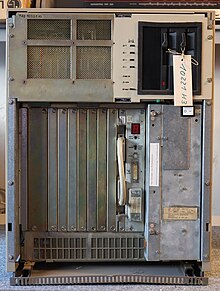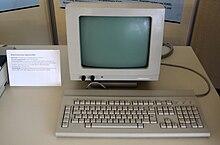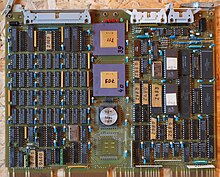K 1820
K 1820 was a workstation ( workstation ). His name was accurate RVS (computer system with virtual memory) K 1820 and his cipher in SM EVM (SKR) of the former countries of the CMEA (Comecon) was CM 1720 . It was developed from October 1988 in the GDR by VEB Robotron-Elektronik Dresden in Dresden and should go into series production in January 1991.
Development history
The K 1820 was a replica of the MicroVAX II from Digital Equipment Corporation (DEC). The import of Western 32-bit Computers, in the area of the CMEA was prepared by the CoCom technology embargo hindered. In addition, the CPU of the MicroVAX II was the first microprocessor to be protected by the Semiconductor Chip Protection Act of 1984. Therefore, at that time, an in-house development had to be carried out to cover the need for modern CAD computing technology based on a 32-bit architecture . Replicas of the MicroVAX II are also known from Hungary (MicroSTAR 32 or TPA-11/510) and the Soviet Union (СМ 1702).
The K 1820 expanded the range of the DEC- VAX -compatible computer line in the SKR, whereby the K 1820 models achieved around 90% of the performance of the K 1840 ( RVS K 1840 , compatible with the DEC-VAX 11/780) from Robotron. The K 1820 was intended as a powerful CAD workstation computer for circuit and printed circuit board design as well as for the construction of mechanical components. It should also be used as a CAM computer in production planning and control and in office automation. The K 1820 was fully software compatible with the K 1840 so that system and user software that had already been developed could be used.
The K 1820 was to be produced from 1991 with an annual number of up to 10,000 units in the K 1821/1822 version (workstation) and up to 1,500 units / year in the K 1823 version (process computer, department server) until 1995. The industrial sales price for a K 1822 was calculated at around 125,000 marks . An expense of M 36.4 million was estimated for the development of the K 1820 and M 16.5 million for its transfer to production.
The K 1820 is based on the VLSI U80700 microprocessor system, the 32-bit CPU U80701 of which was developed based on the MicroVAX CPU MicroVAX 78032 . In addition to the CPU, a number of circuits had to be designed according to DEC models. The circuit development up to the functional model took place partly at Robotron-Elektronik Dresden itself under the leadership of VEB Mikroelektronik "Karl-Marx" Erfurt and in cooperation with the cooperation partners Carl-Zeiss Jena ( Center for Microelectronics Dresden ) and the Central Institute for Cybernetics and Information Processes Berlin of the Academy of Sciences of the GDR . The circuit board design and construction followed our own drafts. There was functional and plug-in compatibility with the Q22 bus from DEC.
A VT220 -compatible K 8941 terminal was developed to operate the K 1820 . For the use of the K 1822 as a CAD workstation, an interactive graphic terminal K 8919.11 with a maximum screen resolution of 1280 × 1080 pixels was provided based on the EC 1834 .01.
From 1995 a successor model K 1830 (corresponding to MicroVAX III) based on the microprocessor system U80900 (model CVAX 78034 ) should replace the K 1820.
Around ten functional models of the K 1820 had been built by March 1990. In the middle of 1990 the development was stopped because an economic production under market economy conditions after the monetary, economic and social union and the associated breakdown of traditional markets in the Soviet Union and in Eastern Europe was no longer given.
At least one functional model of a K 1822 is in the depot of the Dresden Technical Collections .
hardware
The K 1820 was designed in three basic versions:
- K 1821 - OEM version as 19 ″ rack with front panel for installation in 19 ″ cabinet
- K 1822 - Individual device as a supplement to the workplace, designed with a fixed base or with a chassis with the dimensions (height × width × depth) 650 × 490 × 367 mm and a weight of around 65 kg
- K 1823 - Cabinet version with extended storage peripherals or I / O hardware, e.g. B. Server for a planned BDS operating data acquisition system or as a process computer
All variants were based on the 19 ″ insert KBE1, the max. 12 logic modules (as plug-in units with direct connector), the front module, the back wiring module, the power supply module and up to eight 5.25 ″ drives.
The KBE1 could be equipped with the following logic modules:
-
Central processing unit ZVE KAC20 with the following main components:
- a processing unit; Essentially consisting of the 32-bit microprocessor (CPU) U80701 and the 32-bit floating point processor ( FPU ) U80703
- a CPU interface controller based on the CPU interface gate array (CIGA) U80709
- a KBUS (corresponds to the Q-Bus from DEC) interface control based on the bus interface gate array (BIGA) U80711
- a local storage subsystem with a maximum of 16 Mbytes of storage capacity, 1 Mbyte of which is implemented directly on the ZVE module,
- a KBUS map device, as part of the memory subsystem, for the assignment of addresses in the KBUS address space to local memory addresses
- a local I / O subsystem including real-time clock (MC146816) with battery backup
- a console subsystem including a V.24 interface (DIGITAL Link asynchronous receiver / transmitter DLART U80707), which takes over the control of the computer system in every halt state, enables operation and implements self-diagnosis
- a clock supply based on three oscillator circuits to provide the system-determining clocks:
- 40 MHz system clock for CPU and FPU, which has been reduced in the processor to a real 5 MHz (CPU micro cycle: 200 ns)
- 32.768 kHz for clock and interface clock
- Interval timer clock of 614.4 kHz
- a central control unit based on programmable logic sequencers (PLS 82S167A or 82105A) and programmable logic arrays ( PLA 16L8A)
- MSC20 memory module
- The module MSC20 has a storage capacity of 8 MB, realized with 1-Mbit DRAM -Schaltkreisen U61000 from Dresden Microelectronics Center (ZMD) of the combine Carl Zeiss Jena . 1 or 2 modules can be installed in a K 1820 computer. The data exchange between the KAC20 and MSC20 takes place via special plug connections.
- External storage controller PKDX2
- The intelligent external storage controller PKDX2 is used to connect 5.25 "floppy and hard disk drives. The interface is compatible with the Seagate ST506 / 412 interface with 5 Mbit / s transfer rate. The PKDX2 is controlled by a microprocessor (DC 310). Data exchange between the controller and the main memory takes place via DMA . Communication with the controller takes place via the MSCP protocol (Mass Storage Control Protocol). The controller firmware enables hard disks of type K 5504.50 (46.77 MByte) and diskette drives of type K 5601 ( one-sided, 80 tracks, 10 sectors, 512 bytes / sector) One or two PKDX2 modules can be installed in a K 1820.
- Local network controller RONAK
- The RONAK connects the computer to the ROLANET 2 local network . The ROLANET2 fully complies with the Ethernet specification (coaxial cable, data rate 10 Mbit / s) and thus also with the international standard ISO 802/3. Up to two RONAKs can be used in a K 1820.
- Multiplexer AHV16
- The AHV16 is an intelligent multiplexer controlled by two single-chip microprocessors. It implements 8 asynchronous full duplex channels, DMA-controlled or programmed single character transmission when sending, FIFO buffer (256 characters) for receive data, separately programmable send and receive data rates in one channel, connection of devices with the interfaces V.24 , V.10 or IFSS by using an appropriate distributor or converter.
- DMA controller ARV16W
- The ARV16W is a universally applicable DMA interface for the direct transfer of 16-bit data words between the main memory and a user I / O device. Data output (DATO) and data input (DATI) take place after a DMA request via the KBUS if the ARV16W is the bus master. The interface works with unbalanced signals with TTL level. With the ARV16W, burst transfers (word-by-word or continuous), byte addressing and read-modify-write cycles are possible. The address and the vector can be set using switches. The I / O device is connected via two 37-pin D-subminiature sockets.
- Diagnostic module DARXAT
- Power supply module STM 1820
- The current consumption of the K 1820 can be a maximum of 6 A at 220 V mains voltage. The power supply provides the voltages 5 V with max. 66 A and 12 V with max. 17 A with a maximum output of 450 W. DCOK (direct voltage ok), POK (mains voltage ok) and LTC (50 Hz pulse voltage) are generated as bus signals. The three fans of the basic computer device are supplied by the STM 1820 with a fan voltage dependent on the ambient temperature and monitored for minimum speed.
Operating systems / software
As operating systems that were VMS -compatible SVP1820, the UNIX - clone MUTOS1820 and the real-time operating system RVSDES1800 provided. Compilers for the programming languages C , Modula-2 , Fortran 77/88 and for COBOL , Common Lisp , Prolog and Ada were available for the K 1820 .
Numerous application programs for the K 1840 should also be available for the K 1820, such as B. the CAD software PROCAD (model: MEDUSA ) and GBS1800 (3D CAD based on GKS 1800) as well as the database software DABA32 ( Ingres compatible) and ALLDBS (model: Oracle ).
successor
For workstations / minicomputers in the power range around 3 MIPS , the MicroVAX should be based on the development of the MP 900 circuit system (U80900, CMOS, structure width 1.5 µm, model CVAX 78034) for the system K 1830 (MicroVAX III) in the VEB Robotron Electronics Dresden -Architecture line of 32-bit microcomputer systems to be continued. The aim was even to achieve the performance parameters of the scaled version of the processor (structure width 1.0 µm, model CVAX +, 3-4 MIPS) in the first implementations, and symmetrical multiprocessing with 4 processors for expanded minicomputer variants (K 1833) (corresponding to VAX 6340), so that a performance range of up to 15 MIPS could be achieved. The production launch of the K 1830 system was planned for 1994/95.
literature
- Dieter Walter: History of the VEB Robotron Electronics Dresden (p.40) ; (PDF; 1.1 MB).
- Claus Preußler, Klaus-Dieter Weise: Compilation of the computer technology products produced in the VEB Kombinat Robotron, Part 1: Computers and computer systems (p.10) ; (PDF; 140 kB).
- Specifications workstation 32 bit K 1820 based on the MP 700 microprocessor family. VVS d 063–247 / 89, VEB Robotron-Elektronik Dresden, March 1989, Saxon State Archives Dresden 11594-1361 / 1-2; (PDF; 4.8 MB).
- Functional specifications U80702 , U80703 , U80707. VVS d 063–284 / 89, VVS d 063–267 / 89, VVS d 063–270 / 89, VEB Robotron-Elektronik Dresden, February 1989, Saxon State Archives Dresden 11594-1361 / 1-2
- Author collective: User manual K 1821 / K 1822. VEB Robotron-Elektronik Dresden, November 1989; (PDF; 1.0 MB).
- Collective of authors: Technical manual ZVE KAC20. VEB Robotron Electronics Dresden, December 1989; (PDF; 1.2 MB)
- Collective of authors: Concept for the development of computer technology up to the year 2000. 1st version. VVS d 063-430 / 89, VEB Kombinat Robotron, Dresden, September 15, 1989; (PDF; 11.7 MB)
- Author collective: update of the perspective component range for the period 1990-1995. VVS b 410-24 / 89, VEB Kombinat Mikroelektronik, Erfurt, November 3, 1989; (PDF; 0.2 MB)
Web links
- History of the Robotron combine from the AG Computer Technology of the Friends of the Technical Collections Dresden
- Technical Collections Dresden
- K 1820 on robotrontechnik.de
Individual evidence
- ↑ MicroVAX II
- ↑ СМ 1702 (in Russian)
- ↑ Horst Niepel, Klaus-Dieter Weise: Product line ESER personal computers of VEB Kombinat Robotron , Dresden 2007 (PDF; 876 kB)
- ↑ US Patent US4933845 A: Reconfigurable bus, Digital Equipment Corporation






